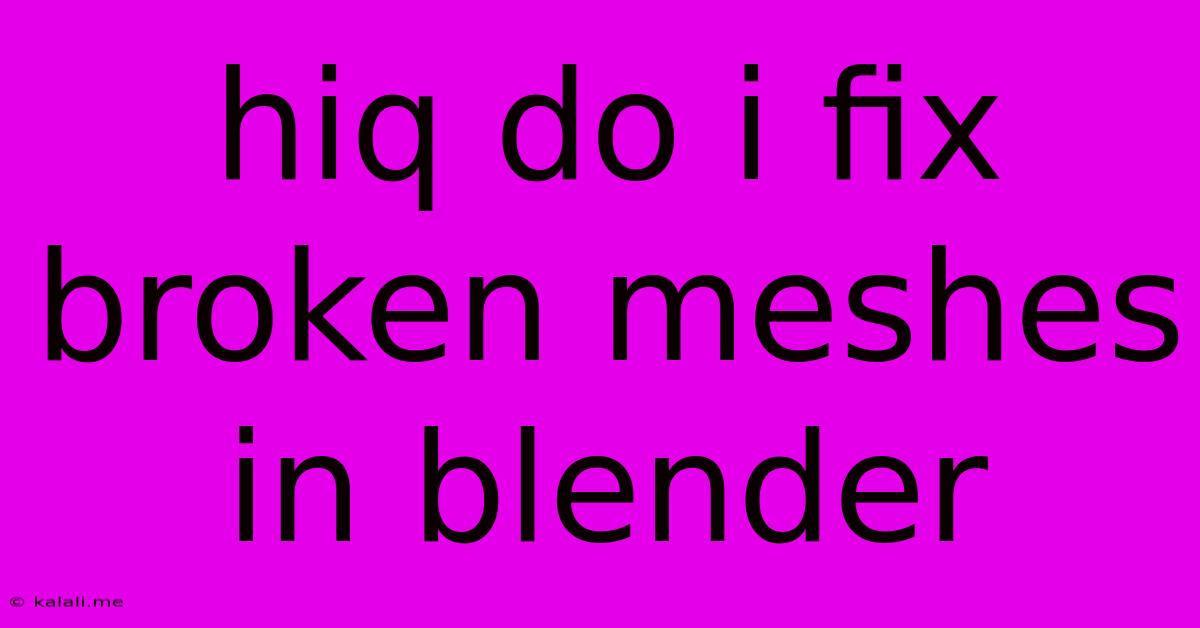Hiq Do I Fix Broken Meshes In Blender
Kalali
Jun 06, 2025 · 3 min read

Table of Contents
How Do I Fix Broken Meshes in Blender? A Troubleshooting Guide
Fixing broken meshes in Blender can be frustrating, but with the right techniques, you can mend those troublesome models and get back to creating. This guide will walk you through common causes of broken meshes and provide effective solutions for repairing them. This includes addressing issues like non-manifold geometry, holes, and disconnected vertices. Whether you're a beginner or an experienced Blender user, understanding these techniques is crucial for a smooth workflow.
Understanding Broken Meshes: Common Problems
Before diving into solutions, let's define what constitutes a "broken" mesh in Blender. Broken meshes usually exhibit one or more of the following problems:
-
Non-manifold geometry: This refers to areas of the mesh that violate standard topological rules. Common examples include overlapping faces, edges that connect more than two faces, or faces that share only a single vertex. These irregularities often prevent smooth rendering, export issues, and can lead to crashes during certain operations.
-
Holes in the mesh: Gaps or holes in the surface are another common issue. These can be small, almost invisible imperfections, or large, obvious gaps in the model. Holes prevent a clean and solid 3D model.
-
Disconnected geometry: Parts of the mesh might be completely separated, forming individual, unconnected islands. This often results from improper modeling techniques or errors during importing.
-
Incorrect normals: Normals define the direction a face is pointing (inward or outward). Incorrect normals can cause shading issues, particularly during rendering, resulting in the model looking visually broken.
Fixing Broken Meshes: Practical Solutions
Now let's explore how to repair these common issues. The specific approach will depend on the type of breakage.
1. Identifying and Fixing Non-Manifold Geometry:
Blender offers powerful tools to identify and repair non-manifold geometry:
-
Select > Select All by Trait > Non-Manifold: This will highlight the problematic areas of your mesh. You can then manually adjust these problematic edges and vertices using tools like Extrude, Inset Faces, or Merge by Distance. Sometimes deleting the offending geometry and rebuilding the section is a cleaner solution.
-
Mesh > Clean Up > Merge by Distance: This tool merges vertices that are very close to each other. This can be useful in fixing small irregularities.
2. Closing Holes and Gaps:
For smaller holes, Blender's Fill tool can be used. Simply select the edges surrounding the hole and use the Alt+M shortcut to select Merge.
Larger holes require more careful consideration:
-
Manually filling: Select the edges surrounding the gap, use the F key to create new faces.
-
Using loop cuts and extrude: Create loop cuts around the hole, then extrude the newly created faces inwards to fill the gap.
3. Reconnecting Disconnected Geometry:
-
Select both parts: Using the selection tools (box select, circle select, lasso select) select the disconnected parts of your mesh.
-
Bridge Edge Loops: The bridge edge loop tool helps create smooth transitions between disconnected parts of your mesh.
4. Correcting Normals:
-
Select the problematic faces or the entire object: Use the select menu or keyboard shortcuts.
-
Mesh > Normals > Recalculate Outside/Inside: This will flip the normals so they point outwards or inwards, respectively.
-
Mesh > Normals > Flip: Flip the selected normals to solve specific shading issues.
Preventing Broken Meshes: Best Practices
Preventing problems is always better than curing them. Here are some tips to help avoid broken meshes in the first place:
-
Clean Modeling Techniques: Pay attention to your modeling workflow. Avoid overlapping faces and ensure edges connect cleanly.
-
Regular Mesh Checks: Periodically check your mesh using the Non-Manifold selection to catch problems early.
-
Careful Importing/Exporting: When importing or exporting models, make sure you’re using the correct file formats and settings. Improper handling can easily damage a mesh.
-
Incremental Saving: Saving your work frequently avoids losing progress if Blender crashes.
By understanding the causes of broken meshes and implementing these solutions, you'll significantly improve your Blender workflow and create cleaner, more robust 3D models. Remember patience and persistence are key – fixing broken meshes can sometimes be a meticulous process.
Latest Posts
Latest Posts
-
3 Way Light Switching Wiring Diagram
Jun 07, 2025
-
How Do You Invert A Picture
Jun 07, 2025
-
Dnd 5e So Much Homebrew Pf2
Jun 07, 2025
-
Ocarina Of Time Lost Woods Map
Jun 07, 2025
-
Mount Dry Erase Board Without Screws
Jun 07, 2025
Related Post
Thank you for visiting our website which covers about Hiq Do I Fix Broken Meshes In Blender . We hope the information provided has been useful to you. Feel free to contact us if you have any questions or need further assistance. See you next time and don't miss to bookmark.